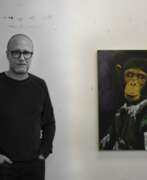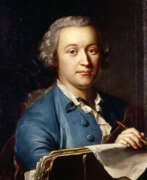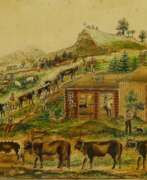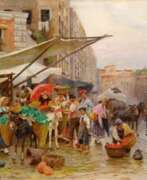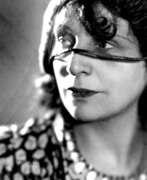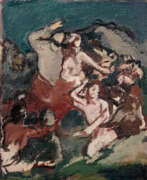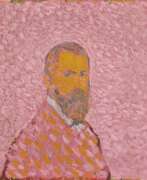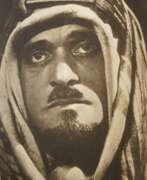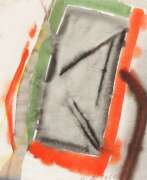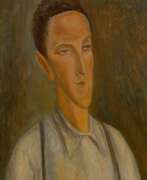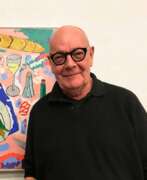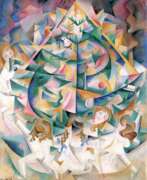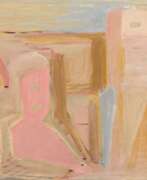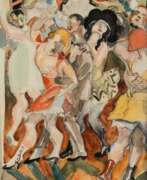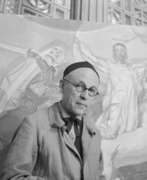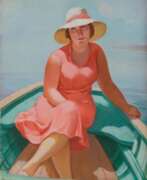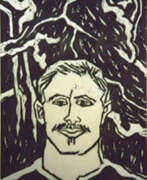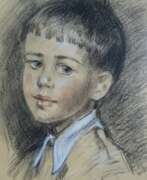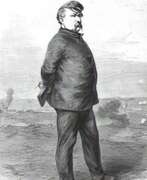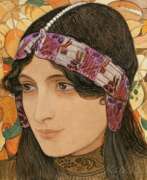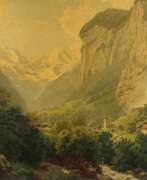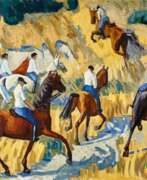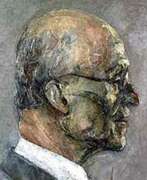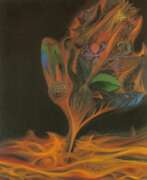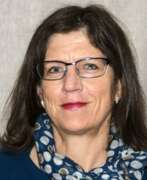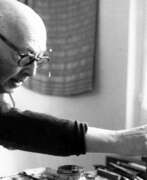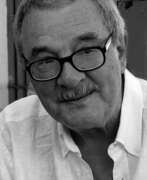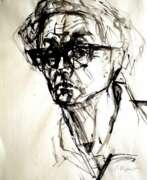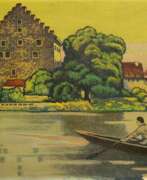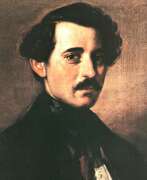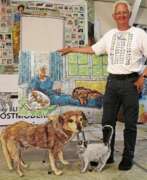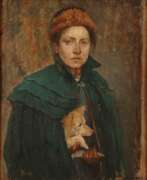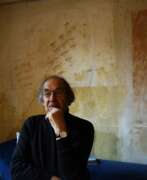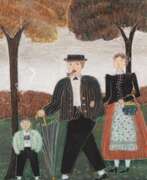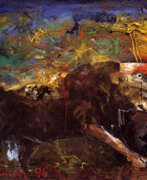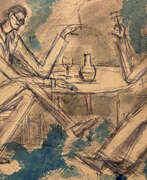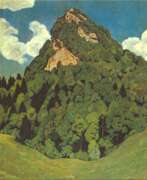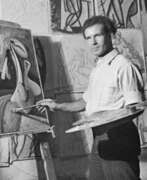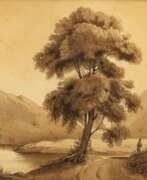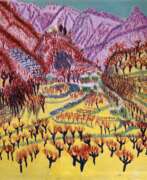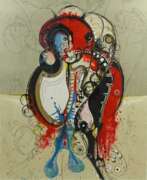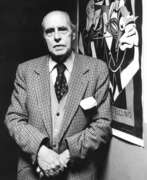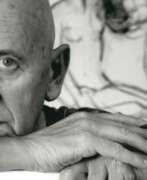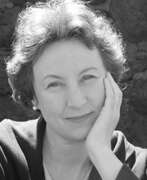Painters Switzerland
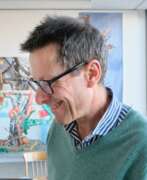

Urs Aeschbach is a Swiss media artist working in various techniques. Nature is always a pictorial theme in Urs Aeschbach's paintings. Her main characters are mushrooms, woody plants, animals, jellyfish, as well as dogs and horses. The artist's paintings are inspired by photographs and illustrations. In addition to paintings, Eschbach creates art and construction projects, video works, as well as constructions and installations.
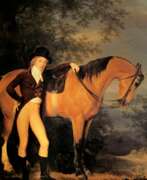

Jacques-Laurent Agasse is a Swiss animal painter.
As a young man he studied at the veterinary school in Paris and was well versed in equine anatomy. In 1880 he moved to London and began painting dogs and racehorses, as well as exotic animals such as giraffes and zebras, which he observed in London zoos. Later, Agasse began to paint landscapes, portraits, and genre scenes as well.
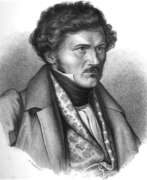

Samuel Amsler is a Swiss engraver. He studied his art under Johan Heinrich Lips and Karl Ernst Hess, at Munich, and from 1816 pursued it in Italy, and chiefly at Rome, till in 1829 he succeeded his former master Hess as professor of engraving in the Munich academy. The works he designed and engraved are remarkable for the grace of the figures, and for the wonderful skill with which he retains and expresses the characteristics of the original paintings and statues. He was a passionate admirer of Raphael, and had great success in reproducing his works.
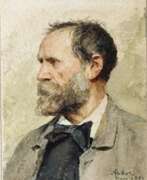

Albert Samuel Anker was a Swiss painter, gesture painter and graphic artist.
Albert studied at the École Nationale Supérieure des Beaux-Arts in Paris and exhibited his work at the Paris Salons, where he was awarded a gold medal in 1866. Anker painted many realistic portraits and genre scenes of ordinary Swiss life. In many of them he depicted children, including his own. Thanks to his paintings, Albert Anker was the most popular genre painter of 19th century Switzerland. He also decorated more than 500 earthenware plates for the Alsatian ceramicist Theodor Deck.
Anker was a member of the Grand Council of the Canton of Bern, initiated the creation of the city museum, and held the rank of officer of the Legion of Honor.
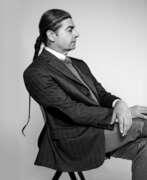

John Armleder is a Swiss performance artist, painter, sculptor, critic, and curator. His work is based on his involvement with Fluxus in the 1960s and 1970s, when he created performance art pieces, installations and collective art activities that were strongly influenced by John Cage. However, Armleder's position throughout his career has been to avoid associating his artistic practice with any type of manifesto.
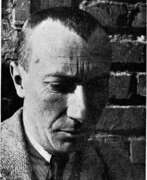

Jean Arp, born Hans Peter Wilhelm Arp, was a German and French poet, painter, graphic artist and sculptor. one of the founders of the Dada movement in Zurich.
Arp used abstract forms in his work and experimented with different materials such as wood, metal and stone. He was also known for his poetic works, in which he applied a method of randomly selecting words, called the "clutter method". Arp believed that this method helped him express his thoughts more precisely and originally. Arp's influence on the arts is still significant today.
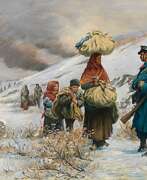

Rodolphe Auguste Bachelin was a Swiss landscape, history and portrait painter as well as a writer, historian and art critic.
He was interested in the Lombardy War of 1859 and in particular in the Franco-Prussian War of 1870 to 1871, which provided him with several subjects with its troop surge at Les Verrières. The Neuchâtel painter was greatly influenced by the writings of Rodolphe Töpffer and aspired to become a Swiss national painter.
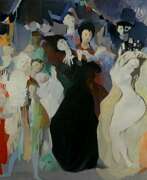

Karl Otto Bachmann, a Swiss painter, graphic artist, and illustrator, began his artistic career in Luzern before moving to Zurich and pursuing freelance work. He achieved a breakthrough in 1943 with the publication of his "Faust" portfolio. Bachmann drew inspiration from his travels across Europe, often joining circus troupes for income and creative ideas. His paintings were characterized by imaginative and virtual settings, with themes revolving around the stage, carnival, and circus. Bachmann's elegant lines, delicate colors, and harmonious compositions made him a respected book illustrator. He actively participated in numerous exhibitions throughout his life, both domestically and internationally.
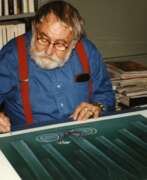

Jan Balet was a German/US-American painter, graphic artist and illustrator. Affected by the style naive art he worked particularly as a graphic artist and as an Illustrator of children's books. Besides this he painted pictures in the style of naive art. Referred to as a "naïve" painter, his works exhibit a dry wit and refreshingly candid, satirical view of life.
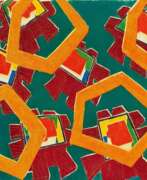

Stefan Berger-Teichmann is a contemporary Swiss painter who specializes in abstract art. He has exhibited his works in various galleries and museums in Switzerland, Germany, and the United States.
Berger-Teichmann's paintings are characterized by their expressive use of color, texture, and form. He often employs a variety of techniques and mediums to create layered, multi-dimensional works that invite the viewer to engage with the art on both a visceral and intellectual level. His work is often inspired by natural landscapes, but he also draws on his own emotional experiences and personal memories to create abstract compositions that are both powerful and evocative.
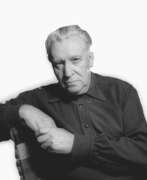

Edmond Bille was a Swiss artist. Bille engaged in intense and varied activity as painter, engraver, stained glass artist, journalist, writer, and politician. He is the creator of the stained glass windows around the altar of the Cathedral of Lausanne, capital of the Swiss canton of Vaud.
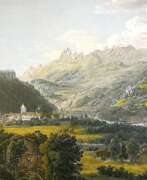

Johann Ludwig Bleuler, sometimes called Louis Bleuler, was a Swiss landscape painter, engraver and publisher.
He studied painting under his father, the painter Johann Heinrich Bleuler the Elder (1758-1823), and his older brother, the painter Johann Heinrich Bleuler the Younger (1787-1857). He traveled extensively in the picturesque Rhine region, painting landscapes and making sketches, and made study trips to Brussels, Amsterdam, and Paris.
In 1824 Bleuler founded his own publishing company in Schaffhausen and from 1827 he worked on a series of engravings of landscapes of the Rhine from its source in the glaciers of the Alps, eventually publishing a complete set of engravings by about 1843. All of the aquatints were hand-colored using the gouache technique, giving them the appearance of the work of old masters.
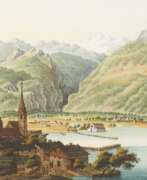

Johann Heinrich Bleuler the Elder was a Swiss landscape painter and engraver.
Bleuler the Elder first trained as a porcelain painter at the Kilchberg-Schooren porcelain manufactory near Zurich. In the early 1780s he settled in Feuertalen and became the founder of the dynasty of artists that is known as the "Bleulerische Malschule". His two sons, Johann Heinrich Bleuler the Younger (1787-1857) and Johann Ludwig Bleuler (1792-1850), also became artists and continued their father's work. And in total, there were up to 25 artists in the dynasty, including godchildren and other relatives.
Bleuler the Elder created mainly landscapes of the Rhine, painted in gouache and watercolor, panoramic views of Swiss cities. He also worked as an art teacher.
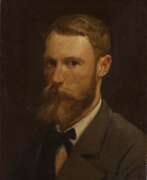

François-Louis David Bocion was a Swiss impressionist painter. He was originally interested in historical subjects, then became a landscape painter and marine painter. He painted some of his famous paintings in Venice, and Bocion gained international fame primarily as the "painter of Lake Geneva.
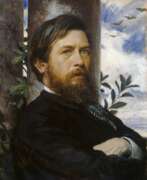

Arnold Böcklin was a Swiss symbolist painter.
Influenced by Romanticism, Böcklin's symbolist use of imagery derived from mythology and legend often overlapped with the aesthetic of the Pre-Raphaelites. Many of his paintings are imaginative interpretations of the classical world, or portray mythological subjects in settings involving classical architecture, often allegorically exploring death and mortality in the context of a strange, fantasy world.
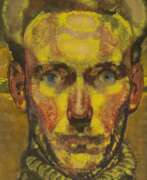

Rodolphe-Théophile Bosshard was a Swiss painter who is best known for his cubist-inspired landscapes and nudes.
Bosshard is considered one of the influential Swiss artists of the early 20th century. He exhibited in Paris together with Pablo Picasso and Marc Chagall.
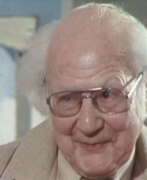

Francis Bott war als deutscher Maler ein Vertreter der „Zweiten École de Paris“, also des französischen „Informel“. Sein künstlerisches Schaffen weist zwei scheinbar gegensätzliche Schwerpunkte auf: surreale, phantastische Gegenständlichkeit und tachistisch, geometrische Abstraktion. Sein Werk besteht aus Gemälden, Glasmalereien, Handzeichnungen, Aquarellen, Gouachen, Plastiken und Objekten; auch als Bühnenbildner hat er sich betätigt.
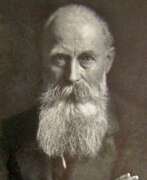

Eugen Felix Prosper Bracht was a German landscape painter.
A late Romanticist painter, Bracht was known for his moody landscapes and coastal scenes in North Germany, and began a sketching trip through Syria, Palestine and Egypt from 1880 to 1881. In 1882, he became a Professor of Landscape Painting at the Prussian Academy of Arts.
Later, Bracht became a representative of German Impressionism.
In 1901, he obtained a teaching position at the Dresden Academy of Fine Arts that he held until 1919.


Leo Brunschwiler was a Swiss painter and stone sculptor.
Brunschwiler trained as a stone sculptor in Küssnacht and attended the Basel School of Applied Arts in Olten. In 1945, he began working as a master sculptor of sculpted tombstones, striving to give this craft the status of high art. Brunschwiler became a member of the Association of Swiss Master Sculptors and Stonemasons and for decades presented his work to a competent jury in specialized competitions. He also published his work in the association's journal Kunst und Stein ("Art and Stone"). These efforts were not in vain, and by the end of his life the sculptor was internationally recognized.
Leo Brunschwiler also created altars for churches and fountains in public places.


Frank Buchser was a Swiss painter. He is noted for his portraits of notable American figures of the post civil war period and for his works with Oriental themes.
His oeuvre comprises about 1000 works in oil, including about 300 full paintings. The remainder are mostly independent sketches, often executed with spiritedly rapid strokes, which show the artist's pronounced sense of color and light. The most important collection of his works are in the Kunstmuseum Solothurn (80 paintings) and the Kunstmuseum Basel (over 1000 oil sketches, drawings and watercolors and sketchbooks).


Louis Buvelot, born Abram-Louis Buvelot, was a Swiss landscape painter who lived 17 years in Brazil and following 5 years back in Switzerland stayed 23 years in Australia, where he influenced the Heidelberg School of painters. Buvelot is best known for his great contribution to Australian art. His works, mostly oil landscapes, are quite well regarded, but perhaps his impact was even greater as a tutor of several members of the Heidelberg School. His enthusiasm for plein air painting (that is, painting directly in the open air) was a key characteristic of those artists' work.
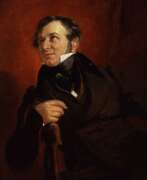

John James Chalon was a Swiss artist of French descent who worked in England.
Chalon came to London as a young man, studying and working. His favorite subject matter was the landscapes of his native Switzerland, and he painted both scenes at sea and genre paintings of peasants and everyday people. Chalon also painted costume sketchbooks, which are lively and authentic studies of Parisian manners and costumes from 1820-1822.
In 1808 he and his brother, the painter Alfred Chalon (1780-1860), founded the Society for the Study of Epic and Pastoral Drawing, and in 1841 John James Chalon became an Academician of the Royal Academy.
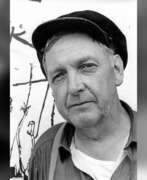

Ernst Stocker, better known as Coghuf, was a Swiss painter, draftsman and sculptor. He designed tapestries and stained glass windows.
Coghuf's work is characterised by abstract forms, bright colours and a sense of dynamic movement. Coghuf's work often conveys emotional depth and explores the relationship between form and space.


Plinio Colombi was a Swiss painter and graphic artist. For his paintings he often chose landscape motifs of the Lake Thun region and also painted still lifes. His works include prints, paintings, etchings, aquatints, lithographs, woodcuts, drawings, and posters.
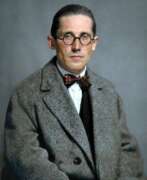

Le Corbusier, born Charles-Édouard Jeanneret in Switzerland, was a visionary French architect, designer, and writer who profoundly influenced modern architecture and urban planning. His innovative ideas blended functionalism with bold sculptural expressionism, embodying the essence of the International Style of architecture. Notably, Le Corbusier's designs, such as the Villa Savoye and the master plan for Chandigarh, India, are celebrated for their revolutionary approaches to living spaces and urban environments.
Le Corbusier's early life in La Chaux-de-Fonds, Switzerland, where he was immersed in the art and craft of watchmaking, significantly shaped his design principles. His architectural journey began without formal training, starting with his education in decorative arts and leading to significant collaborations across Europe. Le Corbusier's philosophy was deeply rooted in the belief that architecture should improve living conditions, particularly in crowded cities. This belief drove his contributions to the Congrès International d'Architecture Moderne and his development of influential architectural principles, such as the Five Points of Architecture, which are exemplified in Villa Savoye.
Villa Savoye, located in Poissy, France, stands as a testament to Le Corbusier's innovative approach, featuring pilotis (reinforced concrete stilts), a functional roof garden, an open floor plan, horizontal windows, and a free façade design. These elements collectively embody his vision of a "machine for living," integrating the house with its environment and the modern lifestyle. Despite facing issues with structural durability and weather resistance, Villa Savoye remains a pivotal work in architectural history, symbolizing the transition to modern architectural thought.
Le Corbusier's legacy is multifaceted, extending beyond architecture to furniture design and painting, showcasing his broad artistic talents. His work continues to inspire and provoke discussion, reflecting both his groundbreaking contributions to modern architecture and the complexities of his ideologies and methodologies.
If you are inspired by Le Corbusier's visionary approach to architecture and design, and wish to stay informed about related updates, consider signing up for our newsletter. This subscription will keep you in the loop about new product launches, sales, and auction events that are directly related to Le Corbusier's enduring legacy. Dive deeper into the world of architecture and design, and ensure you don't miss out on opportunities to engage with Le Corbusier's influential work. Sign up now to connect with the past, present, and future of architectural excellence.
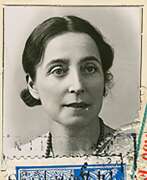

Margherita known as Mara Corradini was an Italian painter and illustrator. Daughter of an industrialist, she studied in Naples, Munich, at the Académie Julian in Paris, in Berlin as a pupil of Martin Brandenburg and then of Henry Luyten at the Institute of Fine Arts in Brasschaat. She obtained the Great Bronze Medal at the 34th International Exhibition of Fine Arts in Naples, as well as in 1912, a 1st class honorary diploma and a gold medal at the Academy of Weimar. In 1924, she won a new honorary diploma at the International Exhibition of Women's Portraits and in 1927 at the International Exhibition in Bordeaux. His paintings Dutch Landscapes and Low Tide were purchased by King Victor-Emmanuel III.
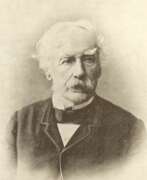

Salomon Corrodi was an Italian-Swiss watercolor painter.
At the age of twenty-two, Corrodi moved from Zurich to Italy, his parents' homeland, and took up the study of watercolor landscape painting in Rome with Jacob Suter (1805-1874). He traveled and painted landscapes extensively, and by the mid-19th century had become a recognized master of watercolor landscape painting as well as a teacher.
Salomon Corrodi lived a long and productive life, laboring until his death and producing many exquisite landscapes of coastal and mountain vistas as well as vedutas. Two of his sons, Herman and Arnold, also became artists.


Jean Désiré Gustave Courbet was a French painter who led the Realism movement in 19th-century French painting. Committed to painting only what he could see, he rejected academic convention and the Romanticism of the previous generation of visual artists. His independence set an example that was important to later artists, such as the Impressionists and the Cubists. Courbet occupies an important place in 19th-century French painting as an innovator and as an artist willing to make bold social statements through his work.
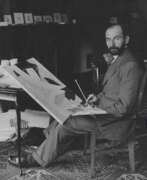

Jean-Joseph Crotti was a Swiss and French graphic artist and avant-garde painter.
Crotti studied at the Munich School of Applied Arts, then at the Académie Julian in Paris. He went from Impressionism to Fauvism, then he became interested in Art Nouveau, Cubism and finally Dadaism. With the outbreak of World War I, Crotti left New York, where he formed close friendships with Marcel Duchamp and Francis Picabia. In 1916, he returned to France. In the late 1930s, Crotti began using a new technique in glass painting called Gemmail.


